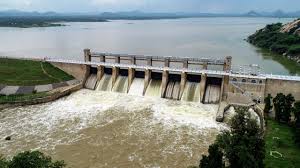CURRENT AFFAIRS
Get the most updated and recent current affair content on Padhaikaro.com
Dam Safety Bill
- Vaid's ICS, Lucknow
- 08, Dec 2021

Why in News?
The Dam Safety Bill, 2019, which provides for the surveillance, inspection, operation and maintenance of all specified dams across the country, has recently got the nod of the Rajya Sabha, after a four-hour discussion. In August 2019, the Bill was approved by the Lok Sabha.
Why is a law on dam safety required?
- India ranks third globally with 5,745 large dams in operation. According to the National Register of Large Dams prepared in June 2019 by the Central Dam Safety Organisation (CDSO) in the Central Water Commission (CWC), 67 dams were built prior to the 20th century and 1,039 dams during the first 70 years of the 20th century.
- For stakeholders of the water sector, ageing of dams in the country has been a matter of concern.
- Jal Shakti Minister told the Rajya Sabha that since 1979, there were 42 instances of dam failure, the latest being Annamayya reservoir in Kadapa district of Andhra Pradesh that led to the death of at least 20 people in November 2021.
- Even though the Central Water Commission (CWC), along with the Central Dam Safety Organisation (CDSO), has been functioning as the apex body to advise States on issues of dam safety, there is no specific Central law that governs the subject, given the situation that the ownership of dams and their maintenance predominantly falls in the purview of the States.
Significance of the Dam Safety Bill:
- Dams have played a key role in fostering rapid and sustained agricultural growth and development in India.
- The Bill will help all the States and Union Territories of India to adopt uniform dam safety procedures which shall ensure safety of dams and safeguard benefits from such dams. This shall also help in safeguarding human life, livestock and property.
- It addresses all issues concerning dam safety including regular inspection of dams, Emergency Action Plan, comprehensive dam safety review, adequate repair and maintenance funds for dam safety, Instrumentation and Safety Manuals.
- It lays onus of dam safety on the dam owner and provides for penal provisions for commission and omission of certain acts.
- So, there has been a long-felt need for a uniform law and administrative structure for ensuring dam safety.
What does the legislation seek to do?
- The Bill covers those dams having the height of over 15 metres and between 10 and 15 metres with certain stipulations.
- It seeks to create two national institutions–
- National Committee on Dam Safety to evolve dam safety policies and recommend necessary regulations, and
- The National Dam Safety Authority to implement policies and address unresolved issues between two States.
- The legislation also envisages the formation of State Dam Safety Organisations and State Committees on Dam Safety.
- Dam owners will be held responsible for construction, operation, maintenance and supervision of dams.
Why has the Bill become contentious?
- In the last 10 years, several States, including Karnataka, Kerala, Tamil Nadu and Odisha, opposed the legislation on the ground that it encroached upon the sovereignty of States to manage their dams.
- Critics also raised the constitutional validity of the legislation in the light of water being a State subject.
- The silence on the payment of compensation to people affected by dam projects was cited as another shortcoming.
- Tamil Nadu has all along been a critic of the legislation as it fears that it will lose its hold over four of its dams, which are located in Kerala.
- The dams include Mullaperiyar, whose structural stability and safety are being debated for over 40 years, and Parambikulam, an important reservoir that caters to irrigation requirements of the western districts of Tamil Nadu including Coimbatore.
Conclusion:
- In his speech in the Rajya Sabha Jal Shakti Ministry contended that Entry 17 of the State List (dealing with “water”) was no bar for the Union to frame a law on the subject.
- However, the PRS Legislative Researchopined that even then, “it is unclear how Parliament would have the jurisdiction to frame a law for dams on rivers where the river and its valley are entirely within a State.”
- Another point adduced in support of the legislation is that inter-State basins cover 92% of the country’s area and most of the dams, making the Centre competent to enact such a law.
The construction of a dam is not a disaster, but the mismanagement and poor planning of the dam is a disaster that affects all of us in a severe manner.
So, the government must consider the issue of dam safety holistically and avoid building large dams for political gains in fragile regions.
FACTS FOR PRELIMS:
Parag Agrawal:
Indian-origin technology executive Parag Agrawal was appointed the new chief executive officer of Twitter after the social media giant’s co-founder Jack Dorsey stepped down.
Indian SARS-CoV-2 Consortium on Genomics (INSACOG):
- The Indian SARS-CoV-2 Genomics Consortium (INSACOG) is jointly initiated by the Union Ministry of Health and Family Welfare, and Department of Biotechnology (DBT) with Council for Scientific & Industrial Research (CSIR) and Indian Council of Medical Research (ICMR).
- It is a consortium of 28 National Laboratories to monitor the genomic variations in the SARS-CoV-2.
- It carries out whole genome sequencing of SARS-CoV-2 virus across the nation, aiding in understanding the spread and evolution of the virus.
- INSACOG also aims to focus on sequencing of clinical samples to understand the disease dynamics and severity